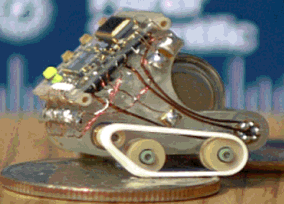 |
A number of researchers have
embraced the idea of miniature robots working together in swarms.
Doug Adkins and Ed Heller developed the robot at
left at Sandia National Lab. At 1/4 cubic inch and weighing less than
an ounce, it is possibly the smallest autonomous untethered robot ever
created. Powered by three watch batteries, it rides on track wheels and
consists of an 8K ROM processor, temperature sensor, and two motors that
drive the wheels. Enhancements being considered include a miniature
camera, microphone, communication device, and
a chemical micro-sensor.
|
No comments:
Post a Comment